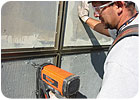
Attaching lath to concrete may be done with alternate approved equipment.


Interiors
The most common material used on interiors is gypsum wallboard and the most common fasteners are nails and/or screws. Most wallboard applicators know that nails are typically spaced 7 inches on center for ceilings and 8 inches on center for walls. However, most are unaware that the new International Residential Code table R702.3.5 footnote E requires 5/8-inch gypsum panels applied to ceilings with framing spaced 24 inches on center now must be nailed to a maximum 6 inches on center if it is a garage ceiling beneath habitable rooms. The code footnote makes no allowance for further spacing with screws and requires they also be spaced a maximum of 6 inches on center.For all fire rated assemblies, contractors should read test reports carefully and use only the listed approved fastener and follow the spacing as listed. Any alteration or substitution to the tested assembly would have to be approved in advance.
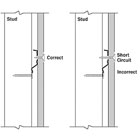
Common mistakes on attaching gypsum panels
A common oversight is the installation of gypsum panels onto resilient channels. Resilient channels are added to wall and ceiling assemblies to improve sound control. The most common mistake in applying gypsum panels to resilient channels is to use a fastener that is too long and then "short circuit" the channel. This can negate the benefits of the resilient channel design in achieving an increased STC rating. This has become quite popular in litigation cases with experts looking for construction defects. It is advised to use shorter screws that cannot reach the framing member or to offset the screws from the framing member to prevent short-circuiting. Your field personnel could save you thousands in legal costs.
Exteriors
Lath is commonly used for Portland cement plaster (stucco) and may be applied over a variety of substrates and to wood or metal framing. Contractors should be familiar with the code for allowable fasteners, styles and spacing.Framing:The common fastener for attaching lath to wood is the staple. The speed of application and lower cost of the fastener make it a logical and code-approved choice for applying to wood framing. Staples must be corrosion resistant, 16 gauge and have a 3/4-inch crown. The legs should penetrate the wood framing member (stud) 3/4 inch. The proper leg length fastener should be the thickness of the sheathing, plus 1/8 inch for the lath, plus 3/4 inch penetration for the wood stud.
Nails are to be 11⁄2 inch long and have a 7/16 diameter head. If sheathing is used, increase the thickness to equal the sheathing. It is recommended that nails to attach wire lath alternate to the side of the wire. This provides additional shear strength for the completed stucco assembly.
Screws are used for attaching metal lath to metal studs. They are commonly known as "wafer" heads or super lathers. The extra wide head helps completely engage the lath to the framing member. The length of screw must be so that at least three threads are showing on the backside of the metal stud.
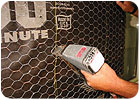
Use a lumber crayon to mark the location of the studs. This will ensure attachment of the lath to the stud.
Common mistakes on framing
One common mistake with application of lath on framing with wood-based sheathing is the failure to attach the lath to the framing member and not merely to the sheathing. The code does require installation of the lath to the framing member and not just the sheathing. A lather should mark the building paper (water-resistive barrier) with a chalk or lumber crayon to mark locations of the studs. Then attach the lath along the studs 6 to 7 inches on center. Attaching an excessive amount of fasteners randomly is not good practice, nor allowed by the codes and could possibly induce water leaks into the wall cavity. An occasional fastener to keep lath from bulging out is acceptable.Concrete or Masonry:The code is unclear on the appropriate fastener for lath and spacing on concrete or masonry. The Northwest Wall and Ceiling Bureau has published a field technical sheet to assist contractors in making the right choice. There are a variety of fasteners that can be used to attach lath to concrete and/or masonry. The right fastener will depend on the substrate.
For example, with masonry and relatively soft mortar joints, the use of masonry nails is more than adequate. For hard concrete, powder-actuated fasteners would be a better choice and supplemental drill-in type anchors may be needed to secure the lath to the wall. Applicators should consider the environment the wall will be subjected to. Areas subjected to freezing rain or freeze-thaw cycles can have lath attachment problems if extra care is not taken.
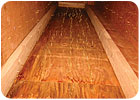
Attachment of lath should be along studs; an occasional fastener between studs is acceptable. This is more than the occasional fastener and could be a problem. The contractor had to remove and replace the plaster system at his own expense.
The spacing for fasteners on concrete can resemble that of framing, a maximum of 24 inches on center (horizontally) and 6 to 7 inches on center (vertically). Attachment for masonry should be along the grout joints to prevent spalling or fracturing masonry units.
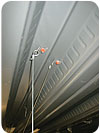
Common mistakes on concrete/masonry
Because attaching lath to a hard substrate can be difficult, many applicators tend to use short fasteners that do not provide adequate holding power. This is particularly true of substrates that have been coated with a paint or other bond-breaking material. The NWCB has been to site investigations where applicators used only stub nails to attach lath, assuming the plaster bond to the concrete or masonry would make up the difference. This is a gamble and sometimes does not pay off, as panels can pull away from the wall.All dealers and contractors should be aware of the ASTM and code standards. Make sure the manufacturer you select conforms to these standards; do not buy fasteners that do not meet or exceed these standards. Manufacturers that meet these standards are happy to produce letters of compliance or copies of the report.
Additional resources
ASTM C 954 Specification for Steel Drill Screws for the Application of Gypsum Board or Metal Plaster Base (lath) to Steel Studs from 0.033 to 0.112 in. in thicknessASTM 1002 Specification for Steel Drill Screws for the Application of Gypsum Board or Metal Plaster Base (lath) to Steel Studs
ASTM C 514 Nails for Application of Gypsum Board
ASTM C-557 Adhesives for fastening gypsum wallboard to wood framing
Staples should comply with the International Code Council Evaluation Service ESR 1539 or NER 272
Powder-actuated, gas or anchor systems should have an evaluation report from the ICC
If you read this article, please circle number 171.


Report Abusive Comment